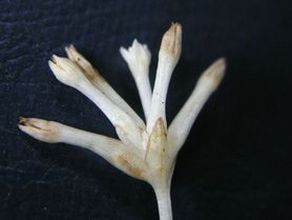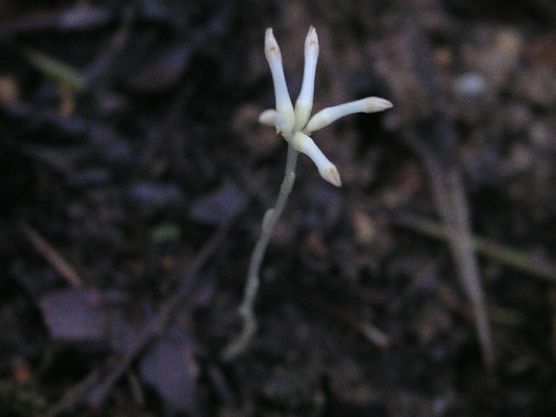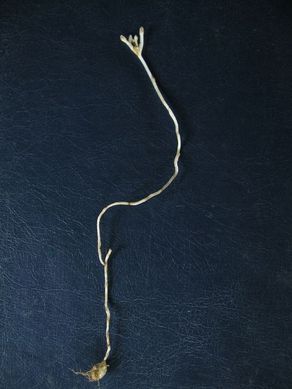Citation : Sameer Ali, D.K. Mesta, M.D. Subash Chandran and T. V. Ramachandra, 2010. Report of Burmannia Championii Thw. From Uttara Kannada, Central Western Ghats, Karnataka., J.Econ. Taxon. Bot. Vol. 34 No. 2 (2010).
Abstract :
Burmannia championii Thw., a saprophytic herb, is reported for the first time in Karnataka from a Myristica swamp in Uttara Kannada district, extending thereby its northern limit of distribution in Western Ghats. Introduction : Burmannia championii Thw., a white filamentous, saprophytic herb of the family Burmanniaceae has been recorded in the undergrowth of a relic forest, the Myristica swamp and adjoining evergreen forest of Kathalekan, Western Ghats, Uttara Kannada, South India. This plant was observed during the ongoing ecological field investigations for the preparation of “Conservation Flora of Uttara Kannada District”. Globally the plant is Oriental in distribution (Sri Lanka, Malayan peninsula, Southern China, Japan, Malayan Archipelago). It has been reported from Kerala in 1977 (Joseph et al., 1979) and from Andaman & Nicobar Islands (Hajra, 1988) in India. This report gives the further extension of the plant to the north of Western Ghats, forming a new addition to the flora of Karnataka. A specimen of Burmannia Linn. was collected from the study site, which was later identified as Burmannia championii Thw., after critical examination and references to relevant floras (Hooker, 1890; Manilal, 1988; Vajravelu, 1990). So far this species is not recorded beyond Palakkad, Kerala, (Joseph, et al., 1979; Hajra, 1988; Manilal, 1988; Vajravelu, 1990; Sasidharan, 2004; Nayar, et al., 2006) and this report will be the northern distribution in Western Ghats. Burmannia championii Thw., Enum. Pl. Zeyl. 325. 1864; Hook. f., Fl. Brit. India 5:666. 1890; Balakrishnan in Bull. Bot. Surv. India. 18(1-4): 230-231. 1976; Joseph et al., in Journ. Bombay Nat. Hist. Soc. 76: 552-553. 1979; Hajra, Fasc. Fl. India. 19: 9. 1988. Manilal, Fl. Silent Valley Tropical Rain forets of India 267. 1988; Vajravelu, Flora of Palghat District 461. 1990; Sasidharan, Floristic studies in Parambikulam wildlife sanctuary 315. 2002. The herb is saprophytic with underground tuber of about 1 cm length and 0.6 cm of diameter. Stem is 7-15 cm high and 1 mm in diameter, slender, white. Scales are 2-4 mm long spirally arranged; basal scales shorter; bracts are 3-4 mm long. Inflorescence terminal, capitate or sub-capitate, 2-7-flowered. Flowers bisexual, wingless; up to 1.2 cm long, white. Outer perianth lobe up to 3 mm; inner perianth lobe 1.5 mm long minutely pubescent. Ovary to 3 mm, oblong ovoid. style thick, filiform; stigma 3-lobed. Capsule ellipsoid-oblong. The shoot with terminal inflorescence is found emerging from a heap of decaying litter and wet soil, during the rainy season. When carefully observed it had a capitate inflorescence at the tip with 2-6 flowers. All morphological aspects tallied with the Burmannia championii Thw.of Joseph et al., 1979.
Flowers: September-October. Habitat: A saprophytic herb found in the undergrowth of Myristica swamps and adjoining evergreen forest. This species is found at an altitude of 552 m in association with Pinanga dicksonii, Gymnacranthera canarica, Myristica fatua var, magnifica and Lophopetalum wightianum. Distribution: India: Andaman & Nicobar Islands, Kerala; Sri Lanka, Malayan Peninsula, Southern China, Japan, Malayan Archipelago. Recently this plant is reported from Taiwan (Sasidharan, 2004., Nayar, 2006., Hsieh & Ohashi, 2000). Specimen examined: India, Karnataka, Uttara Kannada dist., Siddapur, Kathalekan Myristica swamp, 552 m, Diwakar CES/EWRG/Herbaria/4621. Type: Ceylon (Sri Lanka) Thwaites 2735 (Herb. PDA) Isotypes (BM!, CAL, B, G-BIOS, G-DEL, GOTT, P, DR, W). During early monsoon many plants come out of forest floor from the subterranean tubers. Even though it is a common herb in the evergreen forests, during the rainy season, it may have lost the attention of Botanists due to its short life span and appearance like some fungal fruiting body. Acknowledgements : We thank the Ministry of Environment and Forests, Government of India and NRDMS division, The Ministry of Science and Technology, Government of India for the financial assistance Reference :
|
|||||||||||||||||||||||||




